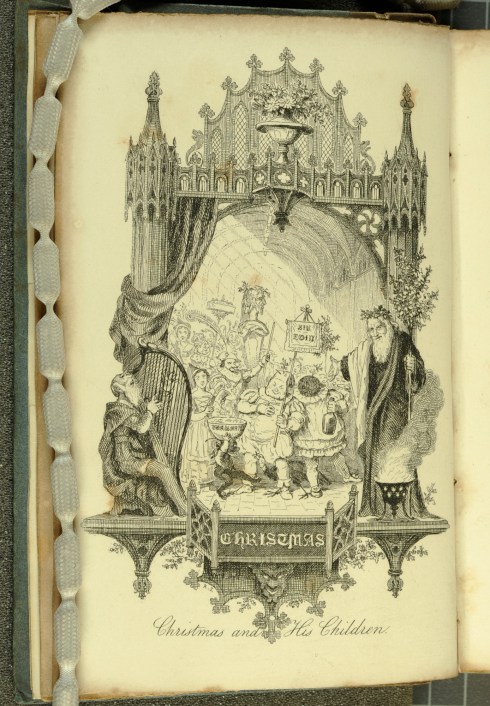A 14th-century manuscript in the Bodleian Library contains the first illustration of mummers, costumed players or “guisers” performing occasionally out-of-doors in a merry band, for amusement and/or some form of compensation. These mummers, wearing masks of stag, rabbit, and horse heads, are in good company: accompanying them in the margins of this cycle of Alexandrian romances are knightly puppets, dancing monkeys, hunting hares, monks and nuns on piggyback, and monstrous men. There is nothing, absolutely nothing, to associate their appearance with Christmas revelry in the text of the manuscript, but several centuries later the Jacobean playwright Ben Jonson did just that in his 1616 Christmas Masque, in which the progeny of Father Christmas personify and epitomize the main institutions of the season: “Mis-Rule, Caroll, Minc’d Pie, Gamboll, Post and Paire, New-Yeares-Gift, Mumming, Wassail, Offering, Babie-Cake”. And from that point on, mumming was an essential part of the Merry Old English Christmas, as described by a succession of English social “historians” in the eighteenth and nineteenth centuries. From his American heritage perspective, the novelist Washington Irving (whose biography of Christopher Columbus laid the very solid foundation for the Flat Earth Myth), contributed to this association with his Bracebridge Hall sketches, first published in 1820. Mumming is part invention of tradition, part social commentary in the industrializing nineteenth century, both a sentimental look back to the way things were in a supposedly-simpler society and a controlled expression of seasonal “misrule” by the villagers or the workers for that society.
Bodleian MS Bodley 264, f. 21v: The Romance of Alexander in French verse, by Flemish illuminator Jehan de Grise and his workshop, 1338-44, with additional sections added in England c. 1400; Illustration from Old England, A Pictorial Museum, edited by Charles Knight (James Sangster & Co, c. 1845).
In the vast revival (or creation) of Merry Old Christmas that occurred over the nineteenth century, one book really stands out for me: Thomas Kibble Hervey’s The Book of Christmas: descriptive of the customs, ceremonies, traditions, superstitions, fun, feeling, and festivities of the Christmas Season (1836). This is really a delightful book, made more so by the original illustrations by Robert Seymour. Hervey presents mumming as traditional custom and folklore, in the company of Morris and sword dances, regional plays and London pantomimes, and Christmas caroling, and definitely de-emphasizes the misrule. And Seymour’s illustrations (which you can see almost in their entirely here) depict the Christmas that we all want to have. Their audience was perhaps interested in escaping the increasingly-complex world that was being created by industrialization and urbanization, but it is rampant Christmas commercialization that makes me want a Merry Old Christmas with mummers, whether it was real or not!
Hervey’s Book of Christmas (1836), with illustrations by Robert Seymour,University of St. Andrews Special Collections.
Modern Mummers (excluding those from Philadelphia–a whole other story!):
Mummers, 1952, Frank Ernst Eurich, Brighton and Hove Museums and Art Galleries; Fritz Wegner commemorative stamp for the 1981 GB Folklore series.













December 24th, 2014 at 8:53 am
Merry Christmas to you!
December 24th, 2014 at 9:11 am
Pretty interesting. A hundred years from now, maybe cos-playing will become part of Christmas.
December 24th, 2014 at 10:34 am
Merry Christmas, and thanks for all your many interesting posts and lovely images. Rick
December 24th, 2014 at 10:47 am
And Merry Christmas to you and yours, Mark, Craig & Rick!
December 25th, 2014 at 2:21 pm
Merry Christmas Donna! Thanks for sharing your knowledge of Salem and other local areas. I see from your Thanksgiving post you grew up in York, ME. Does York have much left from its early colonial days? I have a line that first settled there–the immigrant, Arthur Came, appears there in a 1670 census as a blacksmith. The line stays in York for three more generations, then goes to Buxton. I was wondering what there was to see from the period.
December 26th, 2014 at 8:55 am
Oh yes, Bob–lots of colonial heritage still left in York! Most of which is under the management of the Museums of Old York: http://www.oldyork.org/. Merry Christmas to you as well.